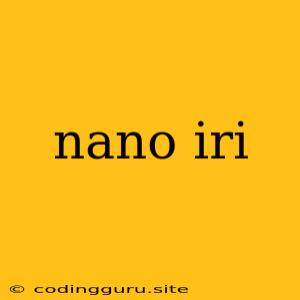Exploring the World of Nano-Sized Iron: Applications and Benefits of Nano Iron
Nano-sized materials, including nano iron, have emerged as a game-changer across various fields, offering unique properties and groundbreaking applications. What exactly is nano iron and why is it so important? Let's delve into the fascinating world of this microscopic marvel.
What is Nano Iron?
Nano iron refers to iron particles with dimensions ranging from 1 to 100 nanometers. This means they are thousands of times smaller than a human hair! This extremely small size gives nano iron a number of unique properties, including:
- High surface area: Nano iron particles have a much larger surface area compared to their larger counterparts, leading to enhanced reactivity.
- Increased reactivity: This increased surface area allows for more contact points with other materials, making nano iron highly effective in various reactions.
- Unique magnetic properties: Nano iron, especially in its magnetic form, exhibits distinct magnetic characteristics that find applications in areas like magnetic separation and targeted drug delivery.
Why is Nano Iron So Special?
Nano iron's remarkable properties make it a valuable player in diverse fields, including:
1. Environmental Remediation:
- Contaminant removal: Nano iron acts as a powerful tool for removing heavy metals, pesticides, and other contaminants from water and soil. Its high reactivity allows it to bind to pollutants, effectively neutralizing them.
- Groundwater purification: Nano iron can be used to clean up polluted groundwater by removing harmful substances, making it a vital resource in environmental sustainability.
- Wastewater treatment: Nano iron plays a crucial role in wastewater treatment, helping to break down organic matter and remove pollutants, leading to cleaner and safer water resources.
2. Medicine and Healthcare:
- Drug delivery: Nano iron can be utilized as a carrier for delivering drugs directly to targeted cells and tissues, enhancing treatment effectiveness and reducing side effects.
- Magnetic resonance imaging (MRI): Nano iron can be used as a contrast agent in MRI, improving the visualization of tissues and organs. This helps doctors make more accurate diagnoses.
- Antibacterial and antifungal properties: Nano iron has shown potential in combating bacterial and fungal infections, offering promising solutions for treating infections.
3. Agriculture and Food:
- Nutrient delivery: Nano iron can enhance the delivery of nutrients to plants, promoting growth and improving crop yields.
- Pest control: Nano iron can be used to develop new and effective methods of pest control, reducing the need for harsh chemicals.
- Food preservation: Nano iron can contribute to extending the shelf life of food products by inhibiting microbial growth and oxidation.
4. Electronics and Energy:
- Magnetic recording: Nano iron is an essential component in high-density magnetic storage devices, allowing for increased data storage capacity.
- Catalysis: Nano iron plays a crucial role as a catalyst in various chemical reactions, contributing to the development of cleaner and more efficient energy technologies.
- Solar energy: Nano iron can be used to improve the efficiency of solar cells, leading to more efficient and sustainable energy production.
5. Other Applications:
- Cosmetics: Nano iron is used in cosmetics for its anti-aging and skin brightening properties.
- Textiles: Nano iron can be incorporated into textiles to improve their durability, stain resistance, and antimicrobial properties.
- Construction: Nano iron can be used to enhance the strength and durability of concrete and other construction materials.
Challenges and Considerations
While nano iron holds immense potential, it's important to address potential challenges and considerations:
- Safety and toxicity: Research is ongoing to ensure the safe use of nano iron, particularly in terms of its long-term effects on human health and the environment.
- Manufacturing costs: Producing nano iron can be expensive, requiring specific technology and specialized equipment.
- Environmental impact: The environmental impact of producing and using nano iron needs to be carefully evaluated to ensure sustainable practices.
Conclusion
Nano iron, with its unique properties and diverse applications, is poised to revolutionize various industries. Its potential to improve environmental remediation, healthcare, agriculture, and countless other fields is immense. However, responsible research, careful assessment of its impact, and continued development of safe and sustainable production methods are critical for unlocking the full potential of this groundbreaking technology.
